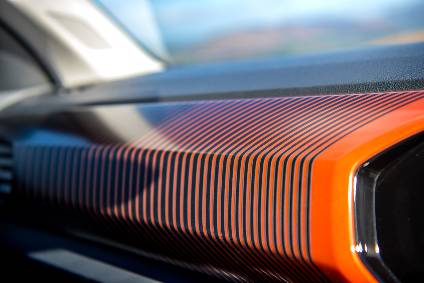
Volkswagen's first entrant into the compact SUV segment – the T-Cross – was launched in the UK last year. It joins a family of VW SUVs, namely Tiguan, T-Roc, Tiguan Allspace and Touareg. Continuing just-auto/AIC's review of interior design and technology trends, we take a closer look inside this model.
The T-Cross was previewed in concept guise at the 2016 Geneva motor show, appearing there in a cabriolet form as the T-Cross Breeze. On first glance, it has a more of a traditional, two-box SUV shape compared to the T-Roc, thereby maximising interior space.
Let's start with some nitty-gritty data. Size-wise, it measures 4,108 mm long and 1,558 mm high. It is, therefore, larger than a Polo (4,053 mm and 1,461 mm respectively) and smaller than a T-Roc (4,234 mm and 1,573 mm). Volkswagen's Modular Transverse Matrix (MQB) architecture allows the driven front axle to be located well forward further improving the car's packaging and use of space.
Four trim levels are offered, namely the entry level S, rising to the SE, SEL and top-drawer R-Line. The spec sheet of our SE model included a long list of standard equipment, from clever safety technology to 17-inch alloys. All SE models come with air-con, stop-start function, power windows and rain sensor. Optional equipment included front sports seats, parking sensors, a spare wheel and a winter pack (comprising heated front seats and heated windscreen washer jets).
The cockpit is jam-packed with the latest technology set out logically thereby making it easy to find your way around. Directly beneath the climate control panel is the storage box for smartphones with two USB ports and an inductive wireless charging pad.
Forward visibility is good with no major blind spots to get bothered about thanks to some relatively thin A-pillars. Rear visibility is not so great (it rarely is in any SUV of whatever size), although a rearview monitor help during parking manoeuvres.

US Tariffs are shifting - will you react or anticipate?
Don’t let policy changes catch you off guard. Stay proactive with real-time data and expert analysis.
By GlobalDataBy virtue of its MQB underpinnings, the T-Cross features a so-called Active Info Display that will be familiar to drivers of Passat, Tiguan and Golf. This replaces the conventional analogue instrument cluster behind the steering wheel. Using a button on the steering wheel, the driver can switch between three layouts and customise the display to suit their preference. Other steering wheel buttons allow you to operate the car's audio system and sat-nav while keeping both hands on the wheel.
The tablet-style eight-inch touchscreen sat-nav is app-like in appearance and more responsive than we have found elsewhere.
Moving to the rear, luggage space in the practical, square shape boot – with height-adjustable floor – provides 385 litres with the sliding (as one) rear seat bench back and 455 litres with it forward. When the 60/40 split rear seat backrests are flipped forward, this liberates 1,281 litres of luggage space. The sliding rear bench means that up to 14 cm of extra leg room is available for the passengers. Storage-wise, the cubbies are a decent size and there is even a sliding drawer under the driver's seat to store odds and sods.
Each spec includes its own cloth type for the interior upholstery, ranging from 'Basket', to 'Carbon Flag', or with coloured upholstery if a design pack is selected – Black, Energetic Orange and Bamboo Garden Green. With the design packs, the T-Cross's upholstery gains a three-tone design, with the bolsters and headrests of the seats finished in complementary colours depending on which pack is selected. Matching coloured dash pads are also offered in these design packs, as well as coloured trim in the steering wheel and centre console.
Connectivity
All models above entry-level S trim come equipped with Car-Net App Connect, which combines the functionality of Apple CarPlay, Google Android Auto and MirrorLink allowing mirroring of a smartphone display on the touchscreen, via a USB connection. At SE spec and above, the car is equipped with four USB charge points for passengers' devices – two in the front of the car, and two in the rear – located at the back of the centre console. Smartphones can be charged wirelessly.
Advanced driver assistance systems
In terms of advanced driver assistance system (ADAS) technologies, the T-Cross ticks a lot of boxes. Standard ADAS equipment includes a front assist area monitoring system with pedestrian monitoring and city emergency braking, lane-keeping assistance, hill start assist; blind spot detection lane change assist system with integrated rear traffic alert. Also available as options are the driver alert system, automatic adaptive cruise control and park assist.
On the road
Our SE press review provided a firm ride on 17-inch wheels. Although in many ways similar to the T-Roc, the T-Cross is cheaper and slightly less powerful. It also comes equipped with a few more practical touches, including an optional folding front passenger seat. Space-wise, knee and head room in the back is quite good for six-footers, helped by the sliding functionality of the rear seat bench – a rarity in this class. Boot space is also generous and yet still manages to squeeze in a full-size spare wheel.
Powered by 1.0-litre petrol with a five-speed manual gearbox, it averaged 41.1 mpg compared to the official combined test cycle of 48.6 mpg. On balance, the T-Cross comes with a generous list of standard equipment, clever safety technology and an intuitive infotainment system. It is manufactured at the Spanish Volkswagen factory in Pamplona alongside the Polo. Rival models include the likes of the Kia Stonic, Skoda Kamiq and Nissan Juke.



